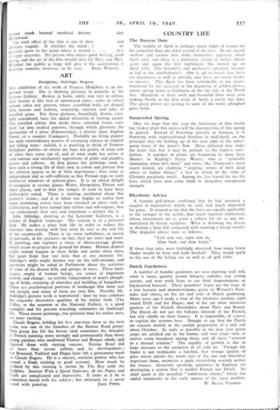Dutch Gardeners A number of humble gardeners are now enjoying
well and, what is more, quickly grown lettuces, radishes and young carrots, and next week hope to cut their magnanimous or big-hearted broccoli. These gourmets' feasts are the issue of a few lectures and demonstrations, given to Women's Insti- tutes and others, on the art and craft of Dutch gardening. Many years ago I made a tour of the intensive gardens right round Delft and the Hague, and of the yet more intensive gardens of the French Maraichers about Paris and Rouen. The Dutch do not use the bell-jars beloved of the French, but rely chiefly on their frames. It is impossible, of course, to explain the systems here. Enough to say that the Dutch art consists mainly in the careful preparation of a rich soil about October. As early as possible in the new year green crops are pricked out in the frames and root crops such as carrots sown broadcast among them, and all these " consent to a mutual relation." The rapidity of growth is due in large measure to the exclusion of all cold air. Though the frame is not technically a hot-bed, that strange quality of glass which admits the warm rays of the sun and thereafter imprisons them, maintains a quite astonishing warmth within the frames. Generally speaking, gardeners in England are developing a system that is neither French nor Dutch. Its chief agent is the so-called "continuous cloche," which has added immensely to the early output of the open gardens.
W. BEACH THOMAS.










































 Previous page
Previous page